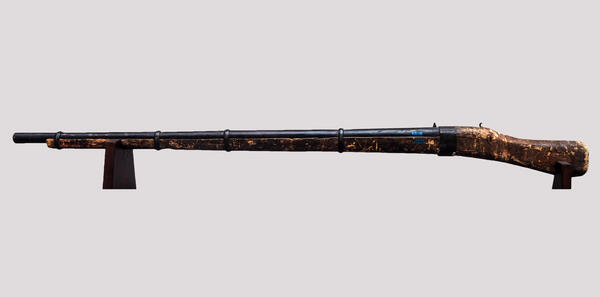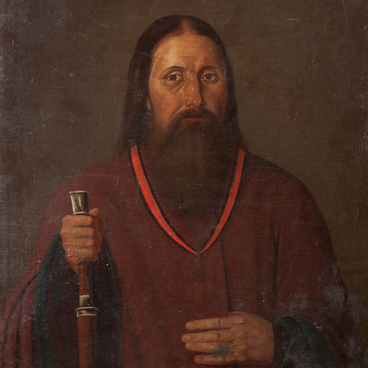Fortress harquebus is a heavy fortress muzzle-loading rifle. The fortress harquebus, in Russian — ‘zatynnaya”- got its name from the Old Russian word “tyn” — a fence, a fortification. This weapon was intended for the defense of fortresses, and later it became known as the fortress gun. In Europe, similar firearms were actively used already in the 15th century and were called “Hakenbuechse” or “hakovnica”. In the Moscow state, such guns became widespread in the 16th century.
Barrels of harquebuses could be forged from iron and cast from cast iron. There were also octahedral trunks. The total length of the light harquebus of the late 15th century is one meter, the caliber is 20-25 millimeters, the igniting hole was on the side. Heavy harquebuses reached two meters. The bullets were made of lead. Fortress harquebuses differed from hand-held firearms in their large size, weight and the presence of a special hook for extinguishing the recoil when fired. They were equipped, as a rule, with a matchlock.
Fortress harquebus from the Smolensk Museum collection has a number of design features. Its barrel is attached to the stock with metal rings, which is typical for early samples of this weapon. This suggests that this sample was made in the 16th century, and, most likely, by local craftsmen. We can say with a high degree of confidence that this exhibit is directly related to the Smolensk fortress and the period of its heroic defense in 1609-1611.
In August 1609, the Polish-Lithuanian Commonwealth turned to open aggression against the Russian kingdom. On September 21, 1609, an unprecedented 20-month defense of Smolensk began against the army of the Polish king Sigismund III. The five thousandth garrison of the city under the leadership of the voivode Mikhail Borisovich Shein held back more than twenty thousandth army of conquerors. An attempt by the Russian side to free Smolensk ended in a disastrous defeat in the Battle of Klushino. After the defeat of the Russian army, the Smolensk regiments retreated to Ryazan.
Almost the entire territory of the Smolensk region was occupied. After repeated fierce assaults, the deserted, burning Smolensk fell on June 3, 1611. The resilience of the Smolensk citizens allowed the Russians to gain time and gather forces for the second people’s militia, led by Minin and Pozharsky.
Barrels of harquebuses could be forged from iron and cast from cast iron. There were also octahedral trunks. The total length of the light harquebus of the late 15th century is one meter, the caliber is 20-25 millimeters, the igniting hole was on the side. Heavy harquebuses reached two meters. The bullets were made of lead. Fortress harquebuses differed from hand-held firearms in their large size, weight and the presence of a special hook for extinguishing the recoil when fired. They were equipped, as a rule, with a matchlock.
Fortress harquebus from the Smolensk Museum collection has a number of design features. Its barrel is attached to the stock with metal rings, which is typical for early samples of this weapon. This suggests that this sample was made in the 16th century, and, most likely, by local craftsmen. We can say with a high degree of confidence that this exhibit is directly related to the Smolensk fortress and the period of its heroic defense in 1609-1611.
In August 1609, the Polish-Lithuanian Commonwealth turned to open aggression against the Russian kingdom. On September 21, 1609, an unprecedented 20-month defense of Smolensk began against the army of the Polish king Sigismund III. The five thousandth garrison of the city under the leadership of the voivode Mikhail Borisovich Shein held back more than twenty thousandth army of conquerors. An attempt by the Russian side to free Smolensk ended in a disastrous defeat in the Battle of Klushino. After the defeat of the Russian army, the Smolensk regiments retreated to Ryazan.
Almost the entire territory of the Smolensk region was occupied. After repeated fierce assaults, the deserted, burning Smolensk fell on June 3, 1611. The resilience of the Smolensk citizens allowed the Russians to gain time and gather forces for the second people’s militia, led by Minin and Pozharsky.



